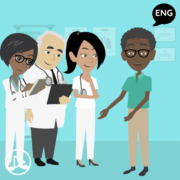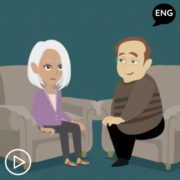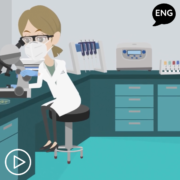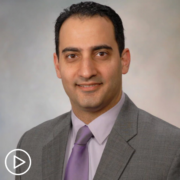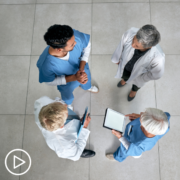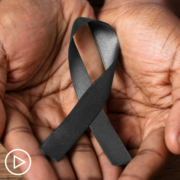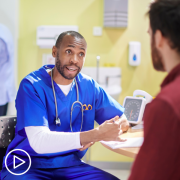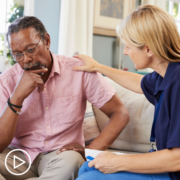Dr. Joseph Scandura, an MPN specialist, discusses the management and monitoring of essential thrombocythemia (ET), polycythemia vera (PV), and myelofibrosis (MF), and shares resources and support for managing day-to-day life with an MPN.
Dr. Joseph Scandura is Associate Professor of Medicine and Scientific Director of the Silver MPN Center at Weill Cornell Medicine. Learn more about Dr. Scandura, here.
Transcript:
Katherine:
Hello, and welcome. I’m Katherine Banwell, your host for today’s webinar. This program is part of our Thrive series. And, today, we’re going to discuss navigating life with an MPN. Before we get into the discussion, please remember that this program is not a substitute for seeking medical advice.
Please, refer to your healthcare team about what might be best for you. Well, let’s meet our guest today. Joining me is Dr. Joseph Scandura. Welcome, Dr. Scandura, would you please introduce yourself?
Dr. Scandura:
Hi. I’m Joe Scandura. I am Associate Professor of Medicine at Weill Cornell in New York City. I am a Physician Scientist. I actually run a lab studying MPNs and hematopoietic stem cells. And I am Scientific Director of the Silver MPN Center at Cornell.
Katherine:
Thank you so much for taking time out of your schedule to join us today. We start all of the webinars in our Thrive series with the same question. In your experience, what do you think it means to thrive with an MPN?
Dr. Scandura:
As a goal, I think it’s very simple, symptom-free and normal life expectancy. Thriving with an MPN is living your life as though you didn’t have an MPN.
Katherine:
And one part of thriving with an MPN is finding a treatment approach that manages your disease, the symptoms of your MPN, and that fits with your lifestyle. So, what are the factors that are considered when choosing treatment for patients with ET, PV, and MF?
Dr. Scandura:
Certainly, the goals of the therapy. So, is the therapy one that I would be looking to maybe delay progression or for long-term potential benefits, or is it something I need now to control short-term risks such as blood clots? The goals of the patient because some therapies may be more suitable to the goals of one patient than another.
And the other – you know, there’s clinical features that may kinda push towards one approach versus another. Certainly, in a 20-year-old patient, I’m thinking about fertility. I’m thinking about a normal life expectancy. In a 90-year-old patient, I have a different set of concerns, multiple medications – what am I going to do that might be affecting their other comorbid conditions?
Katherine:
Right. Right.
Dr. Scandura:
I think about what are my near-term and long-term goals. So, obviously, age becomes a factor there. If I’m 95 years old, no matter what I do that person is not going to live 20 years. If that person’s 20 years old and they’re not living 30, 40, 50, 60 years, that’s a real shame. That’s a huge loss of life. So, that helps kinda point me in one direction or another.
And, then, there’s different types of therapy. There are injectable agents. There are pills. There are drugs that have been used for a long time but don’t really have an FDA approval. There are drugs that are approved for certain indications.
And, as physicians, we can sometimes stretch that based upon clinical judgment. So, I think a lot of that goes into the discussion I have with patients about therapy.
And that’s always – you know, I present to them what the options are, what I think the benefits might be, what the potential toxicities are, and then we discuss.
Katherine:
Right. I would imagine monitoring patients is different for each of the MPNs. So, how are patients typically monitored over time, and let’s start with essential thrombocythemia?
Dr. Scandura:
Yeah. I think – again, it’s similar. You know, what’s near-term, what’s long-term? And so, in all of these diseases, thrombosis risk is a near-term risk. That’s something that I am monitoring in certain ways to help mitigate that risk. In ET and PV, I approach them similarly. Blood counts are certainly – these are diseases of the blood forming system. Certainly, monitoring blood counts I find helpful. But the reality of it is, in ET, there is not a clear linkage between blood counts and risks.
And so, I like to keep the platelet count near normal if I can. But I also recognize that it may not be worth suppressing all of the blood counts to achieve that landmark, because it’s not clear that that’s really reducing the risk any more than just having somebody on a medication that helps control the blood counts. In polycythemia vera, different blood counts are very important. The red blood cells are kind of like part of the clotting risk. We know from clinical trials that keeping the red blood cell parameters within certain ranges reduces the risk of clotting. And so, what I monitor in polycythemia vera is the hematocrit. In women, I like to keep it below 42. In men, I like to keep it below 45.
But I don’t just – I’m not a slave to the hematocrit. I am keeping an eye on the other blood counts and the other red blood cell parameters. So, for instance, what’s the size of the red blood cells? That tells me a little bit about what’s going on in the blood formation for that patient. And what’s the number of red blood cells? So, sometimes people can have very small red cells, because they’re a little iron-deficient and have a huge surplus of the number of red blood cells. And that tells me a little bit about how their blood forming system is responding to therapy.
Iron deficiency in polycythemia vera is very prominent. I personally believe it’s a very major driver of symptoms in patients who are receiving phlebotomy as part of their care. And it’s something that I monitor and really counsel patients on. My goal is to make phlebotomy independent, but it can take a while.
Everybody starts out iron-deficient, and then we take iron out of their body through blood with the phlebotomy. And that makes them more iron-deficient.
Katherine:
Right.
Dr. Scandura:
I monitor symptoms from patients, and sometimes that can tell me that their disease needs to be – their treatment needs to be tweaked a little bit, even something as simple as aspirin. People can sometimes have burning in the skin or itching that is sometimes responsive to changing the aspirin dose or how it’s given, once a day versus twice a day.
And that simple thing can be a big change for a patient who’s kind of, literally, climbing out of their skin or wishing they could and to try and find something that is helping.
I had a patient the other day. He had COVID. I said, “Oh, you should probably get this medication.” Do you have your primary care physician? Who’s taking care of you?” And he goes, “Well, to be honest with you, you’re my guy.” And so, it’s true. I see this patient a lot. And so, sometimes they forget. If I’m not paying attention to their blood pressure, the risks or treatment of diabetes, cholesterol, lipids, their screening programs for mammogram or colonoscopy, health maintenance issues, I do keep an eye on that in patients, because I do think it’s a part of the MPNs.
I think that there are excess risks for patients for some of these factors. Certainly, if you think of it as three strikes, they get a strike for having an MPN. I don’t want them to have any other strikes. So, diabetes, hypertension, those are strikes that I can potentially, at least, treat or refer them to somebody to help comanage with me. And so, that’s kind of my general approach.
Katherine:
What about patients who have myelofibrosis? Are they monitored more closely?
Dr. Scandura:
Yeah, I think it depends a little bit on the patient. Patients with early myelofibrosis often don’t have any symptoms or near-term risks much different than those from ET or PV. As the disease can progress, then some of these patients have more profound problems with symptoms, which I may be trying to find a solution to make them feel better. And also, blood counts can become more of an issue.
Transfusions in some patients who are very high white blood cell count, the spleen is often quite enlarged. Although, in my experience, most patients aren’t really bothered by the size of their spleen as the physicians are. But it is something where I think, on average, they’re monitored a little bit more closely to quite a bit more closely depending on the patient.
Katherine:
Yeah. You mentioned blood counts. And we know that lab results can fluctuate a bit. What happens if someone suddenly has a change in blood counts? What do you do?
Dr. Scandura:
Yeah. I mean, repeat it. That’s the first thing. Also, check what’s going on. It’s not uncommon in patients with MPNs that I’ll see them and the counts are a little bit out of whack, the white count is much higher than it’s been, and questioning them. “Oh, yeah. I had X, Y, or Z last week or the week before.” It used to be a upper respiratory tract infection, or they had a minor surgical procedure.
And sometimes the responses to these things can be accentuated in patients with MPNs. And so, if that’s what of this story, I certainly would repeat it and let things calm down a little. And that’s often all it is. I’m much more of a monitor of the trends. So, one-time measure doesn’t generally excite me. It might make me want to have a follow-up a little more – in a shorter period of time. Of course, it depends on what the change is. But, for most of the changes that we observe, they’re relatively minor. And I will monitor them over time.
If I see a trend where something is progressively increasing or decreasing over time, then I start thinking about what else is going on. And that’s always in the context of what’s going on with the patient. How are they feeling? What’s their physical exam like? What are the other laboratory values like?
Katherine:
When is a bone marrow biopsy necessary?
Dr. Scandura:
I would say a bone marrow biopsy is absolutely necessary at the time of diagnosis. I personally do not routinely monitor by bone marrow biopsy unless it’s part of a clinical trial.
But I do perform a bone marrow or want to look at the bone marrow morphology if there is one of these changes or at least a trend that I want a little bit more information about. And so, if – or if it’s been a very long time since somebody has had a bone marrow. If it’s been five or ten years, then sometimes I may recommend we look just so we can collect a little bit more up-to-date information.
But I don’t routinely do a bone marrow, but I will do it if there are laboratories that are kind of trending in the wrong direction, there’s symptoms, there’s physical findings that I’m just not sure about. And I think it would help me be more sure as to what’s going on and be able to discuss that with the patient. Sometimes, just to say, “Hey. Look, we were worried about this, but the bone marrow looks really good.”
Katherine:
Yeah. Can you talk about shared decision-making? Why is it so important for patients to work closely with their healthcare team on choosing a therapy?
Dr. Scandura:
Because these are therapies that last for a long time. And, hopefully, the patients and the relationship last for a long time. And so, I think that everybody has to be comfortable with the decision about a therapy. And my personal goal is to try to make sure that everybody understands the rationale for a therapy, the potential ups and downs with the therapy, which every drug has, every approach has, and what I’m kind of watching and monitoring. I’m a very – I think that communication relieves a lot of anxiety. I think that the unknown is far scarier than the known, even if it’s not perfect. And so, I think shared decision-making has a role in relieving some of the scariness of unknown.
If we’re discussing to come to a decision, that means that my job is to give you the knowledge that I have so that you can tell me the knowledge about you and what you’re feeling and what you want back. And that back and forth is what helps me do a better job of taking care of the patient and helps the patient understand what’s going on and relieve some of the stress of the unknown. So, I think it’s a very synergistic approach. I don’t think I could practice medicine in another way.
Katherine:
Dr. Scandura, much of our MPN community is highly engaged in their care. What are some educational resources you would recommend for people who are seeking more information about their condition?
Dr. Scandura:
I think that there’s some basic information available from a variety of – for instance, the National Cancer Institute has some basic information. Leukemia & Lymphoma Society has some basic information.
The MPN Research Foundation has some basic information. And then there are some information websites that are run by corporations, which are – I think they try to be even-handed in some of the discussion and has some good information there, too. I think the – none of these is a perfect source of information. I don’t think there is one source that you can go to answer every question that you could ask.
My MPN Center has a website with a bunch of QAs, and we just every now and then add a new one. And it’s just a really long list. So, these are questions our patients frequently ask us, and we sort of put answers there to help guide. But individual details are often more important than sort of generalizations. I find patient – go ahead.
Katherine:
Oh. I was just going to ask, what about the forums, patient forums that are available? Is that something you would recommend?
Dr. Scandura:
What I kind of I find my patients do is they’ll go out and look for information, because patients with MPNs, thankfully, tend to live a long time. And they are often curious about their disease and want to do better and figure out how they can do better. And so, a lot of them will go to whatever sources are available. But, generally, they come back. So, we circle back; we regroup. And sometimes, it’s la-la land, a little bit crazy things, and sometimes it’s really interesting.
I learn a lot, you know, what’s going on in terms of what are patients really reporting, because sometimes in a clinic visit people kind of don’t say everything, or they forget to say something or maybe just my experience. I don’t see every patient in the world, right? So, if it’s something that’s relatively rare, then I may not have seen it with a new drug or something like that.
So, I can learn from that experience as well. So, I think it’s kind of like people go out. They can be like little honeybees and collect all the information from all the flowers out there. And then they come back, and we regroup in the nest. And we discuss and decide what makes sense, what’s relevant to them, and what might help with our decision-making.
Katherine:
Yeah. Managing the worry associated with a diagnosis or concerns even about progression can lead to a lot of anxiety and fear amongst patients. Why is it important for them to share what they’re feeling with their healthcare team?
Dr. Scandura:
I would say this. If our goals are to have people – I mean, this is what I say to patients – I want you to think about this disease when you’re here. And, then, when you’re not here, my goal is to have you not thinking about this disease because you’re feeling okay and you’re comfortable and confident in what’s going on.
So, I want to make it a clinic visit disease. That’s not always possible. But, for many patients, it is. I don’t want somebody to become – to start thinking like a sick person when they’re not. I don’t want the diagnosis to be the disease, right? I want the person if they’re feeling well, to recognize that. Live your life; move on with things. But, at the same time, these kinds of diagnoses are scary.
Katherine:
Yeah.
Dr. Scandura:
And so, it is normal with a new diagnosis or a change in the diagnosis to go through a period of time where you have to adjust. And so, that’s normal, and you have to work your way through it. Some people want to work that all out internally, and that’s good to a certain extent as long as they have good supports at home. But I often want to know how they’re doing, how they’re working through that so I can get a gauge of how it’s affecting their life and the duration where this adjustment is going on.
So, somebody who’s still adjusting to a new diagnosis two years after the diagnosis, and they’re otherwise clinically well, that’s getting into the range where it’s not normal. You might need additional help. You might need counseling. And, in some patients, that might include some medications for a short period of time. The goal is to have the disease affecting you only in so far as it’s affecting you, not the idea of the disease.
Dr. Scandura:
So, that’s a – again, it’s a conversation. There are lots of resources. People, being individuals, deal with things in their own way, and I just try to help understand with them how it’s affecting their life. And, if it seems to be more than I would expect, I’ll tell them that.
And then we can discuss that. It doesn’t mean we have to do something today, but I will tell them, “I think this is maybe a little bit more. Why are you so worried? I think you’re doing great.”
Katherine:
Yeah. Yeah. Can a social worker or somebody else on the healthcare team help with these emotional needs that patients have?
Dr. Scandura:
Absolutely. We have great social workers. I tap into them all the time. We also have a group of psychiatrists who are really interested in kind of psychiatry that’s related to oncology and the diagnoses and how it impacts care. I mean, this is New York City, so everybody has a therapist. But a lot of patients have preexisting connections to healthcare providers or support systems. I think, for some patients, groups are helpful.
Katherine:
We’d be remiss if we didn’t bring up financial concerns, treatment and regular appointments can really become quite expensive. Understanding that everyone’s situation is different, of course, where can patients turn if they need resources for financial support?
Dr. Scandura:
Yeah. It depends on what the issue is. So, one of the biggest areas that I found this can interfere with care is when we have copays that are really not reasonable and not affordable. And so, how do we fix that? How do we get access to an agent that might be beneficial for a patient but that – you know, and the insurance has approved it, but they’ve approved it with such a high copay that it’s just not an option anymore.
And so, there are foundations. The PAN Foundation, we often will reach out to for copay assistance. And, actually, many companies have copay assistance programs for their individual drugs. And so, we have some of our nurses who are quite good at navigating these different agencies, and some of them are kind of drug-specific.
And because we see a lot of patients with MPNs and the number of drugs is not that great, we’re pretty tapped into what are the options for copay assistance that might be helpful. And it often works. It doesn’t always work. I had a patient I saw pretty routinely, and I kind of like my certain group of labs that kind of make me feel like I have a good sense of what’s going on. But he was getting killed with the lab costs. And he mentioned this to me, and then I have to do what I tell my – I have three teenage daughters, right? And, when they were littler – smaller, younger, we spent a lot of time distinguishing needs from wants, right?
So, this was one of those instances. What laboratory do I need to make sure that this patient is safe? What do I want because it makes me feel like I have a better idea of what’s going on? And maybe I can back off on those wants if I’m seeing the patient pretty frequently, which I happen to be at that time. And so, some of that is a conversation.
And it depends on the specifics of the insurance and a little bit of back and forth and knowing how to kind of minimize that financial burden when that’s starting to compromise care.
Katherine:
Yeah. Let’s answer a few audience questions that we received in advance of the webinar. This one is from Sophie, “What complications can arise from an MPN during pregnancy?”
Dr. Scandura:
Well, look, pregnancy – here you have two things, one of them common and complicated and the other one uncommon and complicated. So, common is pregnancy, but every pregnancy is different. And there’s a lot of changes going on in the body, and there’s certain risks that can go along with that as well. So, clotting risks sometimes can be increased in pregnancy. And then you have an MPN, where you have a clotting risk on top of that. The pregnancy really changes what kinds of medications we can think about using. And so, there are certain medications that we use comfortably in patients that would be an absolutely forbidden medication in a pregnant woman.
And so, it depends a little bit on what’s going on with the patient. But, if they have a history of clotting, then certainly, we would think about wanting to control the blood counts. It depends a little bit on what the disease is how we would do that. Interferons are commonly used in pregnancy, and they are safe in pregnancy and can improve the outcomes in some patients with pregnancy.
But short of that, in patients, for instance, who are very thrombotic risk, sometimes we have to sort of balance the risk of having a clot and something that can interfere with the pregnancy and the risk of bleeding. So, it’s not uncommon that people are on blood thinners during pregnancy at some point, but it really depends on the individual patient. What we do here is we keep very close contact with the patients.
And all of our patients are seen by the high-risk OB/GYN. So, it’s not the general obstetrics people who are monitoring the patient, so they’re much more closely monitored for complications of pregnancy. And we are seeing them more frequently during pregnancy to help, from the MPN side, to try to optimize and minimize the risks of clot. And that doesn’t end as soon as the baby’s out. If breastfeeding, their clotting risk is not normalized after pregnancy, as soon as the baby comes out. And so, you know, there’s an adjustment for several months afterwards where we’re still kind of thinking about this person a little bit differently than we would if they were not or had not been recently pregnant.
Katherine:
Yeah. We have another question. This one from Jennifer. She wonders, is there research being done on MPN progression to understand how it happens or even prevent or slow progression?
Dr. Scandura:
Yeah. There’s a lot. I think there is a – from both the sort of basic laboratory using animal models to try to understand what are the kind of systems that are involved in how these diseases change. What genes are involved? How do they talk to each other? You know, these are not cells that live in a vacuum, right? They live in a special microenvironment. What are the signals that crosstalk between the MPN cells, the MPN stem cells, and their microenvironment?
And so, there’s a lot of research on that and the basic side of things. In humans, there’s a lot that has been done over the years in terms of trying to understand what are some of the genetic features of progression. And I think we’re beginning to get a little bit of a better understand of what are the non-genetic things that are associated with progression.
I was part of an effort from the MPN Research Foundation and still am. They have what they call the Progression Network, where they tried to put together a number of investigators from really across the world to share ideas about the nature of progression and how we might look at studying this and understanding ways to prevent progression.
I think we do have some drugs now that show some promise in terms of being able to prevent progression. I think interferons have shown this in polycythemia vera in terms of a promise for improved long-term outcomes and delayed risk progression. I think that the gold standard randomized trials are maturing and are sort of bearing out some of the same findings that have been observed retrospectively, so sort of kind of looking back in time.
But the difficulty is that it can take a long time for patients to progress. And you say, “Oh, that’s great.” And that is great. But, from a research – from a statistical side, it means things are really slow. If you have to wait 15 years to assess whether or not people progressed less in one treatment versus another, it’s really slow going. And so, we have to do a compromise of what’s – you know, what do animal studies say? What does retrospective analysis, when we might have people who started treatment 30 years ago, and now we’re just seeing how did it all work out? It’s not a perfect study, because biases can creep in, but it’s what we have now. And so, there’s a lot. And I think, increasingly, progression is being recognized as a goal of therapy, to prevent progression.
Personally, it is one of major goals, because I think we do a pretty good job at preventing clots with available treatments. But I don’t think we do a very good job at preventing progression, mostly, because we don’t exactly understand what’s driving that. And so, I think until we develop that deeper understanding and really invest the time and effort in terms of learning which approaches can help prevent progression, we’re going to continue to have these questions.
Katherine:
Yeah. Well, thank you for those answers, Dr. Scandura. And please continue to send in your questions to question@powerfulpatients.org, and we’ll work to get them answered on future programs. As we close out this conversation, Dr. Scandura, I would like to get your thoughts on where we stand with progress with MPN care. Are there advances in treatment research that you’re hopeful about?
Dr. Scandura:
Yeah. I think it’s a very exciting time, actually. I think that over the past 5 to 10 years the amount of new drugs that have been developed and tested in patients has grown exponentially. The number of companies that are targeting MPNs for their drug development has expanded dramatically. The number of clinical trials, good quality clinical trials has increased dramatically. And I think the success that’s coming out of that is we start seeing drugs now that are looking to be very, very effective. I don’t want to name individual drugs.
But I know we have a number of clinical trials where we’re seeing things with these agents that we haven’t seen with our traditional therapies, meaning changes in the bone marrow that we haven’t seen before or a normalization of symptoms or blood counts in an area that has been challenging in the past. And so, we now have drugs and a number of drugs going for approval, a number of newly-approved drugs, even interferon, which is a drug that’s been around forever. Well, not forever. But, I mean, I guess forever, yeah, because it’s a natural product.
So, as long as there have been humans, there have been interferons, even before humans. But now we have it. As a pharmaceutical, they’ve been around for decades. And we now have the first – even though we’ve been using it for decades, we have the first approved, FDA-approved interferon for polycythemia vera, which is I think a huge change.
A company invested the money in getting FDA approval for an agent, and that means they have to – the bar’s higher, and they have to prove something that just using it off-label hasn’t. So, I think it’s a tremendously exciting time. I expect it’s going to continue. We’re going to continue to have improvements in care. There’s going to be combinations of drugs. I think that we’re going to see real advances over the next 5 to 10 years.
Katherine:
Well, Dr. Scandura, thank you so much for taking the time to join us today.
Dr. Scandura:
It was a pleasure. It was nice meeting with you.
Katherine:
And thank you to all of our partners. To learn more about MPNs and to access tools to help you become a proactive patient, visit powerfulpatients.org. I’m Katherine Banwell. Thanks for being with us today.
